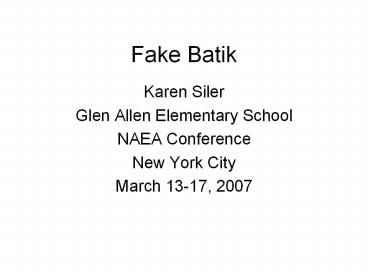Fake Batik - PowerPoint PPT Presentation
Title:
Fake Batik
Description:
Additional muslin to back the pillow. Volunteers to sew the pieces together! Polyester fiberfill to stuff pillows. The Process-The Design ... The Finished Pillow ... – PowerPoint PPT presentation
Number of Views:216
Avg rating:3.0/5.0
Title: Fake Batik
1
Fake Batik
- Karen Siler
- Glen Allen Elementary School
- NAEA Conference
- New York City
- March 13-17, 2007
2
Fake Batik
- Presented by Kirby Ming of Henry County, GA at
the NAEA Conference in New York City, NY - 5th Grade Students
3
Fake Batik
- Batik - A method of dyeing fabric where some
areas are covered with wax or pastes made of
glues or starches to make designs by keeping dyes
from penetrating in pattern areas
4
SOL
- 5.14 - The student will produce fiber art that
reflects the qualities of the fiber art of
another age, culture, or country.
5
History
- Cloth decorated with this technique has been in
use as long back as 1500 years ago in Egypt,
Africa, the Middle East and in several parts of
Asia. Many people think that batik was brought to
Asia by travelers from the Indian subcontinent.
Most people believe that Batik reached its
highest artistic expression in Indonesia,
particularly in Java. Batik has become a very
central means of artistic expression for many
areas of Asia and a deeply integrated facet of
the Asian culture.
6
The Process
- Cotton and silk are used for the cloth.
- Melted wax is applied with a canting, sometimes
called a wax pen. It is a funnel like pen that
has a bamboo handle and the wax comes slowly out
of the tip as the artist draws onto the fabric. - The melted wax is kept in a wajan, a little pan
that sits on a small charcoal stove. Beeswax and
paraffin are the most common waxes used for
batik.
7
- Because batiked fabric grew to be so popular, a
method of making the fabric more quickly
developed. This made the fabric more affordable
to the masses and much quicker to make. - A copper stamp called a cap (pronounced chop) was
made of copper strips bent into the shape of the
design. Then it was dipped in wax and stamped
onto the fabric.
8
Material for Fake Batik
- 12 X 12 white paper, 14 X 14 muslin, pencil,
Sharpie, tape, alum and flour mixture in squeeze
bottles, diluted acrylic paint and brushes.
Additional muslin to back the pillow. Volunteers
to sew the pieces together! Polyester fiberfill
to stuff pillows.
9
The Process-The Design
- Come up with a 12 X 12 design based on
something from nature water, wind, plants,
animals, leaves, etc. Nothing man-made should be
included. Keep it fairly simple. We look at
Hokusais painting The Great Wave and talk
about the movement seen in the wave and the power
as well as the way the water is drawn and how the
color is used. (We ignore the boats this time!)
Trace with a Sharpie on 12 X 12 paper.
10
The Process - The Resist
- Tape muslin onto paper (center). Trace the
lines you see through the paper with the alum
mixture and let dry thoroughly.
11
The Process - Paint
- Students will add color to the batik using
dilute acrylic paint. Students may crack the
resist and paint over it to achieve some of the
crackled effect.
12
The Process - Finish
- When the entire piece is painted and
completely dry. Place the fabric in soapy water
and scrape the paste off. Rinse. Let dry.
13
The Finished Pillow
- Parent volunteers sew each painted to piece to an
unpainted one inside out leaving an opening for
stuffing. Students stuff and then sew the
stuffing hole closed!





![get⚡[PDF]❤ Fake Dating Adrian Hunter: A Spicy Enemies to Lovers, Fake Relationship PowerPoint PPT Presentation](https://s3.amazonaws.com/images.powershow.com/10064992.th0.jpg?_=202406261112)

























